Chair

Needle Case with light brown velvet fabric cushion
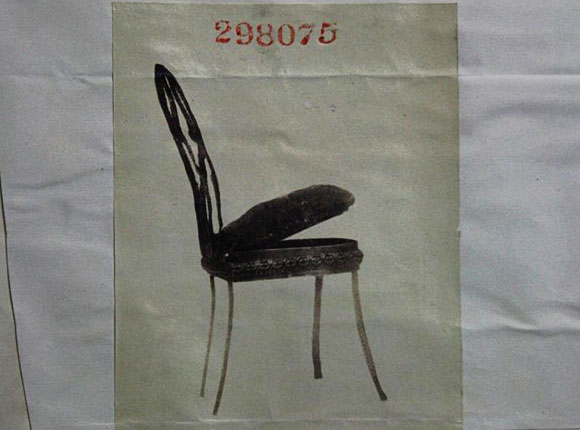
Design Representation
Design Details
Needle Case Type: |
Figural |
Patent/Registered to: |
W. Avery & Son - Redditch |
Patent/Design Representation #: |
Ornamental Class1: Metal: #298075 |
Patent/Design Registration Date: |
February 3, 1876 |
Location of Patent/Design Registration: |
The National Archives (TNA) - Kew, UK |
Reference #: |
TNA Representation - BT 43/39/298075
TNA Register - BT 44/3/298075 |
Dimensions: |
5 x 4.5 x 11.5 |
Material: |
Brass |
Name Variations: |
W. Avery & Son - Redditch |
Other Variations: |
a) With blue velvet fabric cushion
b) With dark brown velvet fabric cushion (a photograph of this needle case can be found at www.averyneedlecases.com)
c) With green velvet fabric cushion
d) With light brown velvet fabric cushion |
Additional Photographs

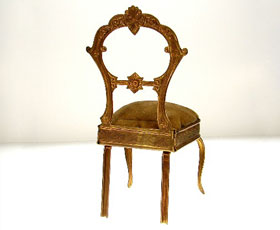
Front open and back
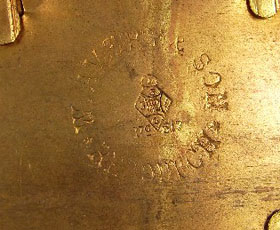
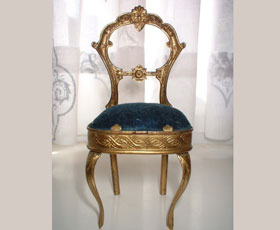
Bottom signature detail and variety with blue velvet fabric cushion (photo courtesy of Inglenook Antiques and
Collectables at www.inglenookantiques.com)
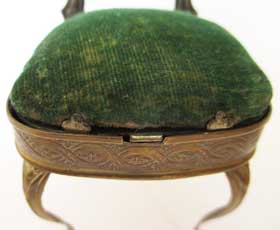
With green velvet fabric cushion (photo from eBay)
Facts
The balloon backed chair was very popular in the Victorian era. The term balloon refers to the back support’s rounded shoulders with
a narrower, nipped-in lower section or waist, with a crosspiece. It was primarily used as a dining chair and considered strong and
comfortable. The chair evolved from its initial form in the 1830s and by the time of the Great Exhibition of 1851, was heavily influenced
by earlier Rococo styling which was revived to meet Victorian taste for ornate decoration. The seat was fabric upholstered over horse
hair padding often button studded. Front legs were cabriole, that is convex curved above and concave below. Back legs swept back
with no stretchers employed.
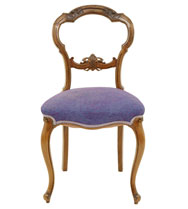
History
The increased affluence of the emerging middle class in the Victorian era created a demand for household furniture which reflected a sense
of luxury and elegance. Revivals of fashion from earlier cultures and periods were adopted. One such fashion, Rococo Revival,
popular from 1830 to 1900, influenced the carving, typically of shells, flowers and scrolls, used to decorate furniture and often less subtly
than in the original, early 18th century, Rococo style. The period has been characterised by rooms overcrowded with heavily ornate
furniture. This was also the era when the first mass produced furniture began to appear made possible by advances in mechanisation.
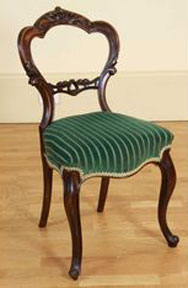
Miscellaneous
A Victorian parlour game, similar to the game musical chairs played today, is called Change Seats. It requires a number of chairs one
fewer than the number of players. The chairs are arranged in a circle with all sitting except the player who is “It” who stands in the
middle. This person calls “Change seats” but players are to remain seated until the word “the King’s come” are added. Then all
player must change seats but not with the players on either side of their chair. The person left without a chair after the mad scramble
for chairs is the new “It”. As an added twist, the “It” might say “the King’s not come” in an attempt to trick players into moving out of
their chairs. Click on the picture below to see a larger version of it.
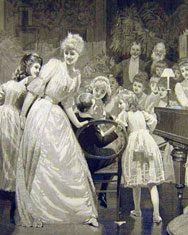
Note: Right side panel text and photos provided by Lynda Herrod.














